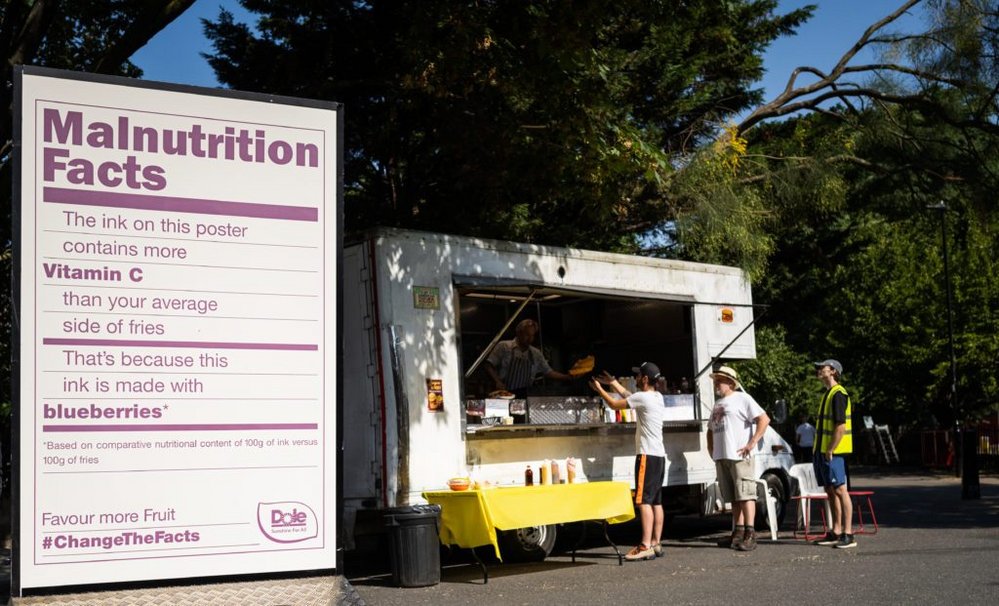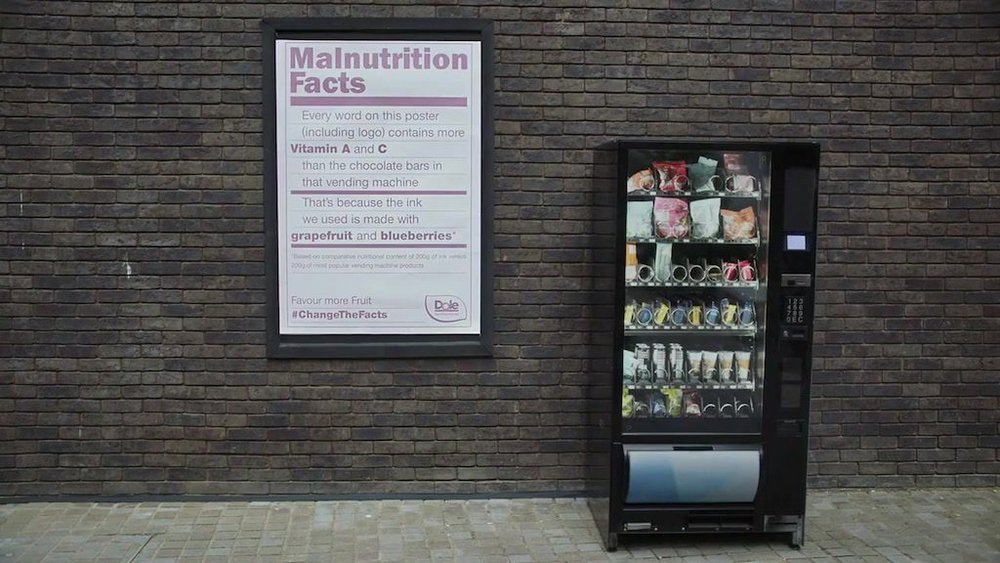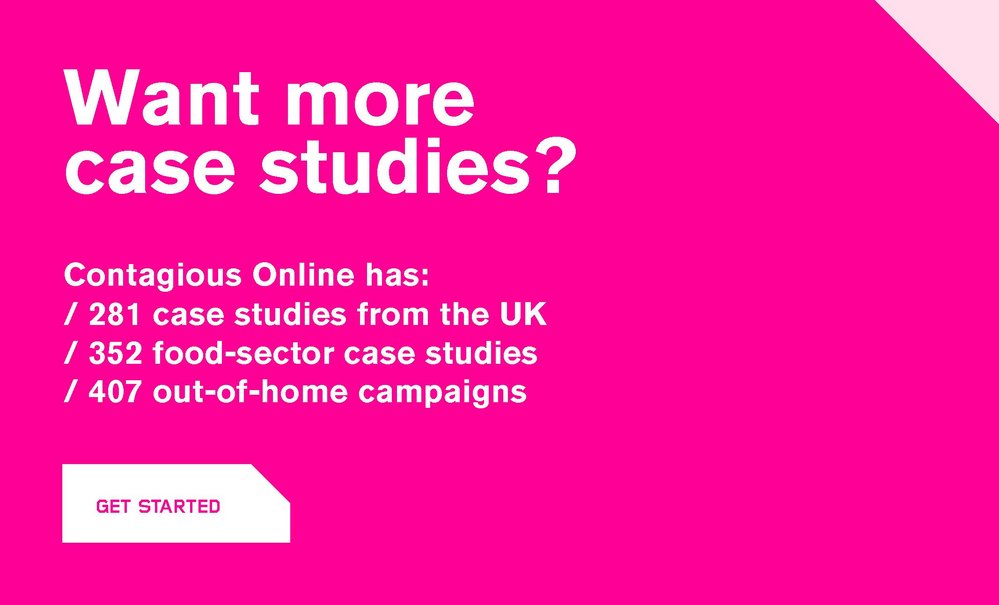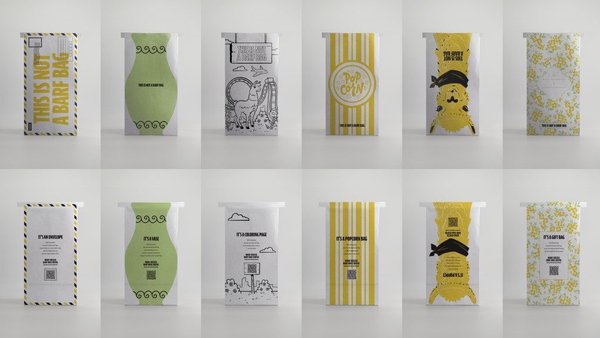Campaign of the Week
Dole’s billboards are more nutritional than chicken nuggets /
Agriculture corporation promotes fresh fruit and veg with innovative billboards printed with vitamin-laced ink
International fresh and packaged fruit and veg company Dole Sunshine Company has launched a third phase of its Malnutrition Labels campaign.
In February 2021, Dole worked with David Madrid and David Miami to draw attention to malnutrition in the US through a striking outdoor campaign.
Using giant projections on buildings in New York, Los Angeles and Baltimore, the Malnutrition Labels campaign displayed facts about food poverty in America, presented in the form of the nutritional labels found on packaged goods. Each projection listed facts that highlighted issues such as obesity, food insecurity and malnutrition, such as ‘1.7 million of deaths worldwide are attributable to low fruit and veg consumption’.
In September that year, Dole marked Hunger Action Month with a second version of the campaign, devised by New York-based agency Lanfranco & Cordova (L&C). The Malnutrition Labels: Food Waste campaign was designed to reduce food waste and fight hunger and Dole plastered Malnutrition Labels on waste and recycling bins, as well as bin bags, streetside bins and waste removal trucks across New York City.

Each label listed a shocking fact about food waste and hunger in the US. For example, one label revealed that ‘3.9 million tons of food in NY end up in the trash every year. Yet 12.8% of New Yorkers struggle with food insecurity’.
In October 2022, Dole worked with London-based agency St Luke’s to create a third iteration of the campaign for the UK. The Malnutrition Labels: Nutritional Ink campaign was inspired by the insight that the UK consumes more junk food than any other country in Europe.
Once again, the creative uses the format of nutrition information labels, this time to share facts about the lack of nutrition in common junk foods. But as with the previous two campaigns, there was an unorthodox element to the out-of-home creative. St Luke’s worked with experience design and creative studio Bompas & Parr, London, to screen-print posters with ink made from real fruit waste.

Using a mixture of discarded fruit including grapefruit, blueberries, grapes, pineapple, oranges, plums and apples, Bompas & Parr experimented with a range of colours and combinations to create inks that could be printed on posters. The posters were then placed strategically around London, at spots where people consume junk food, such as vending machines and hot food trucks.
The posters emphasise the low nutritional value of popular foods with copy such as ‘Every word on this poster contains more vitamin A and C than the chocolate bars in that vending machine. That’s because the ink we used is made with grapefruit and blueberries’ and ‘The words you’re reading contain more vitamin A and C than a chicken nugget. That’s because the ink it’s printed with is made with oranges and red grapes’.
A limited run of posters was displayed (the posters have expiry dates) and the out of home was supported with a film featuring the process of printing the posters. The campaign also includes a partnership with Fair Share, a charity network aimed at relieving food poverty and reducing food waste in the UK.
‘This is not just a one-off stunt,’ Richard Denney, ECD of St Luke’s, told Contagious. ‘This is long term. This is about education as well – understanding the effects of poor nutrition on our health. Brands have to actively play their part. From day one, “What are you doing about it?” has been part of the brief with Dole. If our projects didn't have action in them, then there's no point in sharing them.’
Contagious Insight /
Consistency is key / Despite being the third iteration of the Malnutrition Labels idea, Nutritional Ink is not repetitive; while building upon the US versions of the campaign, it adds something new to the conversation and is tailored to a different audience. Where David Miami and Madrid’s large-scale projections used shock factor, and L&C New York used guerilla-style tactics with labels on rubbish bags and bins, St Luke’s put its own innovative spin on the concept, using food science to land its message. Together, the three campaigns are a strong example of how to build upon a strong positioning – Dole’s goal of contributing to good nutrition for 1 billion people by 2025 – while keeping it fresh.
Tone of voice / As St Luke’s ECD Richard Denney told Contagious, most people hear the word ‘malnutrition’ and think of poverty and starvation. This campaign reframes the word, reminding us that malnutrition refers to a lack of healthy nutrition, and is a common problem in the UK. And while the posters are tactically placed where people might buy unhealthy foods, the tone of the copy is educational, rather than shaming. ‘It is important, while we raise the issues, that we are human in terms of how we approach them,’ explains Dole’s global head of communications, Ranjit Jathanna. ‘It's not your fault that the system is built this way, that a quinoa salad is 15 bucks a pop, and junk food probably costs a third of that.’ ‘Human’ is one of the four Hs that define Dole’s brand tone of voice: human, hopeful, honest and helpful. Rather than shame people for their choices, the Nutritional Ink posters give people the facts to make a more informed decision.
Armed with facts / It’s important when making statements about health and nutrition – and the benefits or efficacy of any product, for that matter – that you come from a place of fact. In this instance, St Luke’s went to painstaking efforts to ensure the accuracy of each statement, working with food scientists to ensure the nutritional information added up while creating visually arresting posters and ensuring that the fruit-based ink was suitable for screen-printing. On top of this, the wording is clear, unemotional, and educational – succinctness that adds to the posters’ impact.
Want more of the same? /
We don’t just write about best-in-class campaigns, interviews and trends. Our Members also receive access to briefings, online training, webinars, live events and much more.







